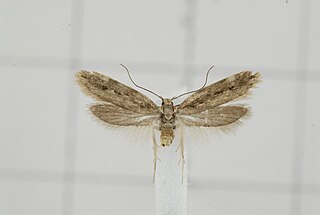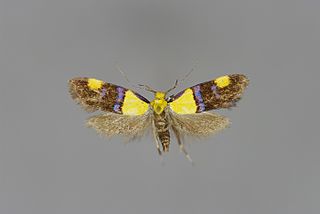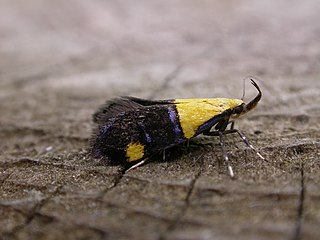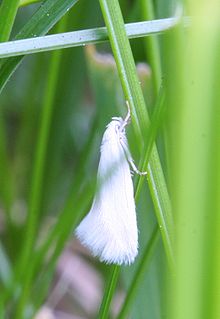Related Research Articles

The Coleophoridae are a family of small moths, belonging to the huge superfamily Gelechioidea. Collectively known as case-bearers, casebearing moths or case moths, this family is represented on all continents, but the majority are found in temperate areas of the Northern Hemisphere. They are most common in the Palearctic, and rare in sub-Saharan Africa, South America, and Australia; consequently, they probably originated in northern Eurasia. They are relatively common in houses, they seek out moist areas to rest and procreate.

Xestia is a genus of noctuid moths. They are the type genus of the tribe Xestiini in subfamily Noctuinae, though some authors merge this tribe with the Noctuini. Species in this genus are commonly known as "clays", "darts" or "rustics", but such names are commonplace among Noctuidae. Xestia moths have a wide distribution, though they most prominently occur in the Holarctic.
Aemilia is a genus of tiger moths in the family Erebidae described by William Forsell Kirby in 1892. It was initially named Ameles, but this name properly refers to a praying mantis genus.

Amastus is a genus of moths in the family Erebidae. The genus was erected by Francis Walker in 1855.

Ethmiopsis is a genus of the twirler moth family (Gelechiidae). Among these, it was previously assigned to subfamily Pexicopiinae, but later moved to the Chelariini tribe.

Oecophora bractella is a species of gelechioid moth. It belongs to the subfamily Oecophorinae of the concealer moth family (Oecophoridae). As the type species of its genus Oecophora, its affiliations and phylogeny determine the delimitation of that family and subfamily.

Erechthias is a genus of the fungus moth family, Tineidae. Therein, it belongs to the subfamily Erechthiinae, of which it is the type genus. The exact circumscription of this genus is still disputed, but it may encompass more than 150 species.
Stenoptinea is a genus of the fungus moth family, Tineidae. Therein, it belongs to the subfamily Meessiinae. It was originally established as a subgenus of Homosetia, but later separated to become a genus in its own right.

Triaxomera is a genus of the fungus moth family, Tineidae. Therein, it belongs to the subfamily Nemapogoninae.

Monopis is a genus of the fungus moth family, Tineidae. Therein, it belongs to the nominate subfamily, Tineinae.

Alabonia is a genus of gelechioid moths. Here, it is placed within the subfamily Oecophorinae of the concealer moth family (Oecophoridae). Alternatively it has been placed in the Elachistidae or Depressariinae together with its presumed closest relatives. It has also been proposed to separate Alabonia and closely related genera as a subfamily Enicostominae, but this has generally not been followed by recent authors regardless of where they placed the present genus.

Oecophora is a genus of the concealer moth family (Oecophoridae). Among these, it belongs to subfamily Oecophorinae. It is the type genus of its subfamily and family. Thus, regardless of the uncertain phylogeny, systematics and taxonomy of its superfamily Gelechioidea, it and its closest relatives always have to be assigned to this family and subfamily as long as these are deemed valid.

Pseudatemelia is a genus of gelechioid moths.
Schiffermuelleria is a genus of gelechioid moths. It is placed in the subfamily Oecophorinae of family Oecophoridae. The genus is treated as monotypic, with the single species Schiffermuelleria schaefferella placed here. As such, its distinctness from the closely related genus Borkhausenia – where S. schaefferella was often placed in the past – is open to debate.
Holcopogon is a genus of gelechioid moths. It is the type genus of the subfamily Holcopogoninae, which is mostly placed within the concealer moth family Autostichidae.

Scythris is a genus of gelechioid moths. It is the type genus of the flower moth family, which is sometimes included as a subfamily in the Xyloryctidae, or together with these merged into the Oecophoridae. The genus was erected by Jacob Hübner in 1825.

Elachista is a genus of gelechioid moths described by Georg Friedrich Treitschke in 1833. It is the type genus of the grass-miner moth family (Elachistidae). This family is sometimes circumscribed very loosely, including for example the Agonoxenidae and Ethmiidae which seem to be quite distinct among the Gelechioidea, as well as other lineages which are widely held to be closer to Oecophora than to Elachista and are thus placed in the concealer moth family Oecophoridae here.

Stoeberhinus testaceus, the potato moth, is a gelechioid moth, supposedly the only species of its genus Stoeberhinus. However, the genus might also include some related moths presently placed in Autosticha. It belongs to the subfamily Autostichinae, which is either placed in the concealer moth family (Oecophoridae), or in an expanded Autostichidae.

Autosticha is a genus of gelechioid moths. It belongs to the subfamily Autostichinae, which is either placed in the concealer moth family (Oecophoridae), or in an expanded Autostichidae. It is the type genus of its subfamily. Originally, this genus was named Automola, but this name properly refers to a fly genus in family Richardiidae.
Fuchsia is a genus of gelechioid moths and only genus of the Fuchsiini tribe. In some systematic layouts, it is placed in the subfamily Amphisbatinae of the concealer moth family (Oecophoridae). Delimitation of Amphisbatinae versus the closely related Depressariidae and Oecophorinae is a major problem of Gelechioidea taxonomy and systematics, and most authors separate the former two as full-blown families, and/or include the Amphisbatinae in Depressariidae, or merge them in the Oecophorinae outright.
References
![]()
- Pitkin, Brian & Jenkins, Paul (2004): Butterflies and Moths of the World, Generic Names and their Type-species – Heloscopa. Version of 2004-NOV-05. Retrieved 2010-APR-24.
| This article on a moth of the family Oecophoridae is a stub. You can help Wikipedia by expanding it. |